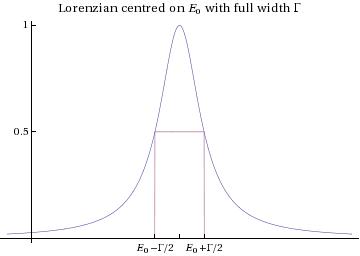
Summary: A full treatment of the effect on states of coupling to radiation is beyond the scope of the course. But we can motivate the fact that a finite lifetime leads to broadening of the state.
In first-order perturbation theory, changes in the initial state are ignored. But in fact we have often been told that a state which can decay with a lifetime has an uncertainty in its energy of the order . How does this arise?
At second order in perturbation theory the first-order expressions for the coefficients () give a non-vanishing expression for the rate of change of the initial state . The mathematical treatment required to do this properly is too subtle to be worth giving here, but the bottom line is (taking as the starting time for simplicity)
which is exactly as one would expect. , which has units of energy, is called the line width; is the total lifetime of the state.
Furthermore if one returns to the derivation of the and allows for the fact that is decaying exponentially (rather than constant as assumed at that order of perturbation theory) we find the integral
The modulus is
This is a Lorentzian;
is the full width at half maximum and its presence tames the energy
-function
we found originally. (Hence sensible results can be found even if there is not a continuum of
photon states.) The upshot is that we no longer need exact energy matching for a
transition to occur; the energy of an unstable state is not precise, but has an uncertainty:
.
